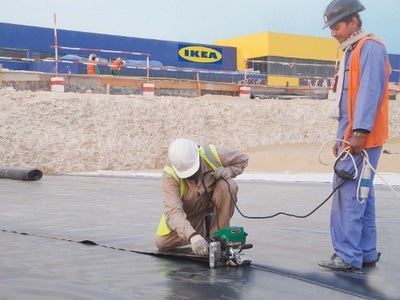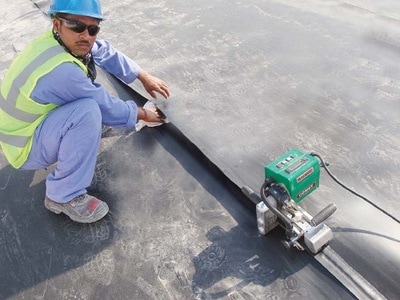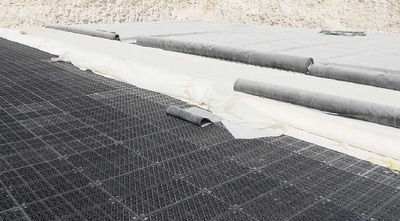|
The globally-active Swedish furniture giant IKEA now even has a few branches in the Middle East. After Saudi Arabia and the United Arab Emirates, IKEA opened a new sales point north of Doha, the capital city of Qatar. The 32,000 square meter (105,000 square foot) building was constructed in just 12 months. On the outside it wears the same typical blue & yellow IKEA branding as with all other 300 branches worldwide. However, the structure in Doha is different in one special respect: a giant reservoir tank has been built here, in which water from the surroundings is collected. It stores the valuable fluid so that it can be used later, after filtration, for irrigation. Plastic baskets Rigolen as a support system The tank measures 42.4 x 24.5 x 2,125 m (L x W x H). The impressive dimensions correspond to a volume of about 2200 cubic meters (7,200 cubic ft.). A special feature of this project is its support structure. Plastic support medium drain trenches were stacked directly in the six-meter (20 ft.) deep trench, on a 15 cm thick layer of sand and the lower part of the sealing system. The individual support media are made of polypropylene and each have the dimensions 740 x 400 x 420 mm (L x B x H), resulting in a considerable overall quantity of 17,670 pieces. They not only support the sealing system with the collected water, but also the 3.7 m thick excavation of sand and earth that lies above the tank, as well as the car park complete with parked customer cars. Hot wedge welder for overlap welding... Since this valuable fluid should be retained without loss, leak- tightness is unquestionably imperative with this tank. The sealing system comprises two layers that surround the entire support construction on all six sides. A heavy geotextile (350 grams per square meter) serves as the inner layer, with an outer layer comprising of a 1 mm thick HDPE sealing sheet. The Doha-based company, Qatar Engineering Material Solutions (QEMS), overlapped and joined the individual sheets with two COMET hot wedge welders. This proven machine is predominantly used in civil engineering projects and in tunnel construction. Thanks to its light weight of just 7.5 kg (16.5 lbs.), the COMET also can join vertical seams perfectly. Therefore is tensioned between the two overlapping sheets and then easily climbs even steep walls or – as here – descends them. In tunnel construction, it is even possible to use the machine for overhead welding. With this project, a total of around 600 m (nearly 2000 ft.) of welding seams were processed at a rate of 2.5 meters (8.2 ft.) per minute. Special features of the COMET include upper and lower drive / pressure rollers that press the two overlapping material together, after heating, with up to 1000 N of pressure, depending on material thickness. They create two parallel 15 mm (0.6 in.) wide weld seams. The cavity in between them serves as a test channel after the welding process. The seal between the two weld seams can thus be tested using an injected test needle and compressed air. Leister is now offering the COMET as a USB version. With this, the relevant welding parameters of speed, pressure, temperature and covered distance can be easily saved and later evaluated. ...Extrusion welder for corners and joints QEMS uses the FUSION 3 extrusion welders from Leister for detailed work on corners, edges, pipe connections and for applying patches. Unlike overlap welding with the hot wedge welder, parts to be welded are joined with extrudate. In doing this, plastic welding rod is drawn into the extrusion welder then shredded, melted and drawn over the parts that are to be joined as a finished extrudate. The handy FUSION 3 outputs extrudate at up to 3.6 meters (11.8 ft.) per minute. In civil engineering, it is the perfect supplement to the automatic welding machines but is also often used for welding PE or PP plates and pipes in plastic fabrication. The two extrusion welders processed about 250 m (820 ft.) of seams for the IKEA reservoir tank. Everything from one source In addition to welding machines and extrusion welders, some hot air tools also were used primarily for detailed work. Here, as always, the TRIAC S from Leister was a reliable tool that never failed even under adverse environmental conditions. QEMS not only installed the entire sealing system, the company also serves as Leister’s distribution. They can therefore carry out their own service and repair work. In sales, customers benefit from the valuable experience of the QEMS assembly teams. Customers also appreciate the ability to obtain all of the equipment necessary for processing plastic from a single source. – From Leister, a supplier that is represented all around the world, as they are here in Doha. Upon project completion the QEMS employees were rightly proud of the result of their work, with the certainty that they could hand over a completely sealed system to the building owner – not least with the help of Leister. It remains to be hoped that the example of IKEA can be replicated elsewhere and that more such reservoir tanks are built in these latitudes... Project: IKEA Holding Tank, Festival City, Doha, Qatar
Sealing system: HDPE Liner, 1.0 mm / geotextile, 350 g/m2 Installation company: Qatar Engineering Material Solutions, Doha, Qatar, www.qems-group.com Equipment supplier: Leister Technologies AG, Switzerland, www.leister.com Text: Reda Ashkar, QEMS / Christophe von Arx, Leister AG Photos: QEMS Comments are closed.
|
|
STANMECH Technologies Inc.
944 Zelco Drive Burlington ON L7L 4Y3 | 1-888-438-6324 | [email protected] Terms of Use Privacy Terms and Conditions of Sale Warranty Policies |
|
Proud Member of:





